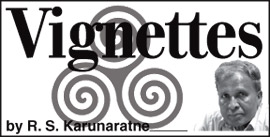Modern philosophy’s rationalist archetype

Even if we have no interest in philosophy, most of us are struggling
to evade answering three basic questions. The answers, if we are
fortunate to find them, underlie man’s every thought, feeling and
action. The questions seem to be simplistic, but they are not. Are we
consciously aware of our thoughts, feelings and actions? Each person can
ask the question: Where am I? How do I know it? What should I do then?
Physically you may be in Colombo or New York. But to answer the
questions meaningfully, you need to know philosophy because it is all
about the fundamental nature of existence of man and his relationship to
existence. The philosophy of the eminent French philosopher René
Descartes (1596-1650) can be a stepping stone to such a philosophical
quest.
Descartes, the French philosopher and mathematician, is considered
the Father of Modern Philosophy. His magnum opus Meditation on First
Philosophy had a hectic impact on the philosophy of mind and
epistemology for more than 300 years. He probed the problems of our
knowledge of the world and said the only thing that you can be certain
of is the fact of your own existence. He summed up his central idea of
philosophy in his well-known maxim Cogito ergo sum (I think therefore I
am).
Human knowledge
|

René Descartes: Cogito ergo sum (I think therefore I am) |
Like most other philosophers, Descartes wanted to put the edifice of
human knowledge upon a secure foundation. He reviewed his own views and
found that some of his ideas were contradictory. However, as a
mathematician, he said that mathematical propositions were certain and
the rest turned out to be false.
He wished to develop some kind of order into this jumble of beliefs.
To do so, he had to begin with what was certain and infallible. But,
like many of us, he faced the inevitable problem of where to begin.
Descartes then decided to examine his own beliefs against a method of
doubt. The process involved questioning the source of his beliefs and
asking whether that was infallible. He derived many of his beliefs from
his senses or perception. He knew, however, that senses could mislead
him. One of his popular examples was that a stick would look bent when
it was half submerged in water. Similarly, the true size of the sun or
moon would be very much bigger than what we see.
As an existential philosopher, Descartes knew that senses could
deceive him from time to time. But he was sure of his existence. For
instance, he was conscious of his sitting in his study. Yet, he found
that there was no way of differentiating between reality and dreaming.
This led him to reject all perceptual knowledge.
Radical deception
According to perceptual knowledge, he knew that a mother was older
than her son. But he realised that he could be deceived at any stage by
a divinely benevolent or malignant being. His idea of radical deception
was the theme of two films, The Matrix and Twelve Monkeys. He also said
that no god or demon could make his existence false. The cogito was the
beginning of an idea through which he tried to prove the existence of
God. However, other philosophers were not impressed by his theory.
Descartes was a Catholic who set aside the so-called accumulated
wisdom of the past. He insisted that each person should examine what is
true and false. In his formative years, Descartes was a frail child. but
he studied Greek. Latin, history, liberal arts and science. His interest
in philosophy, music, dancing and fencing was amazing. At the University
of Poitiers he earned a degree in law.
On November 10, 1619 Descartes had a revelation that transformed him.
Then he changed the direction of Western philosophy. He claimed that he
was divinely encouraged to establish a universal method of reasoning
based on mathematical principles. In later years, he travelled
extensively, studied many subjects and wrote. With all his vast
knowledge, Descartes remained a recluse who preferred to live with his
domestic aids. He lived in 20 houses during a 20-year period.
Public glare
Descartes lived away from the public glare. He avoided meeting his
friends and devoted his time and energy for his studies. Strangely, he
was not immune to the charms of women. He corresponded with Princess
Elizabeth for about six years. The 19-year-old princess was impressed by
his clarity of thinking after reading his Discourse on Method.
Sometime later he joined the court of Queen Christina of Sweden.
Although he had the habit of sleeping late in the morning, the queen
forced him to get up at 5 am. and teach her philosophy. Then his health
began to fail. He died on February 11, 1650.
Descartes was not only the Father of Modern Philosophy but also the
original archetype of the rationalist movement. For rationalists, reason
was the primary source of all knowledge. He advised people not to rely
on what others have said. He said, “We must look at ourselves with new
eyes and new understanding.”
To reach a wider readership, Descartes wrote his views in the first
person. The Cartesian “I” should not be interpreted in a narrow sense
because it also refers to anybody else. In geometry, he said, we begin
with self evident truths such as “A straight line is the shortest
distance between two points.” However, he said that we should not accept
anything we can doubt. That is the ultimate rationalist viewpoint. |

